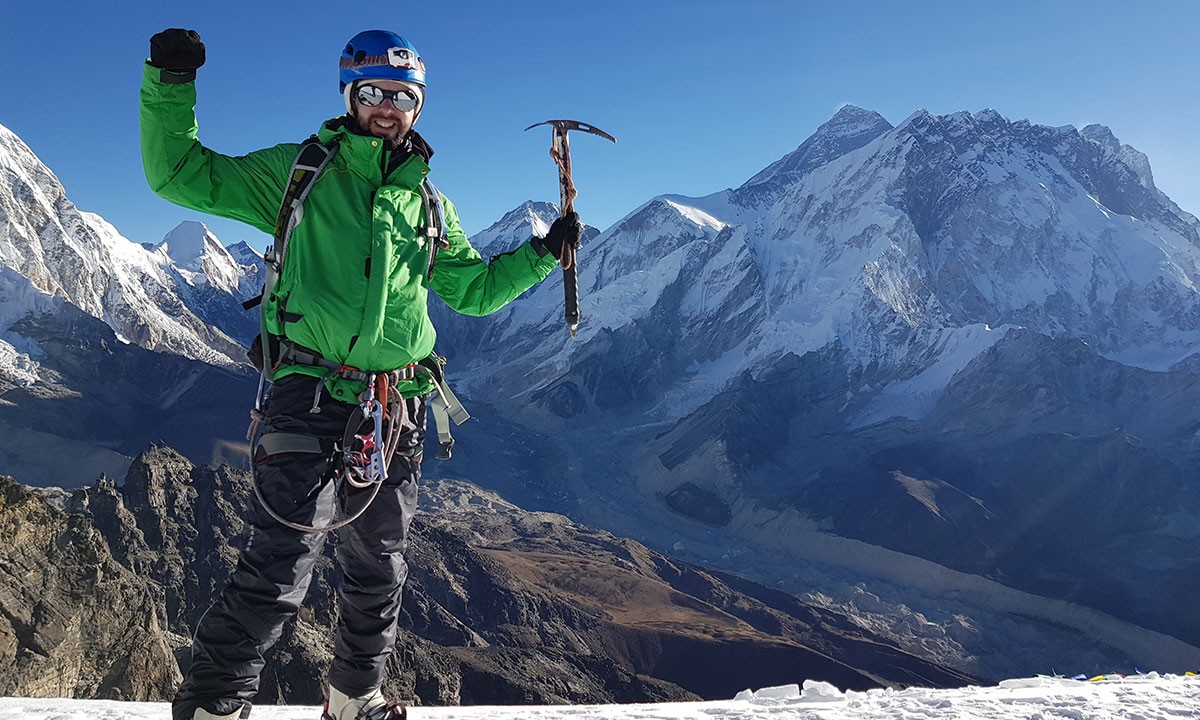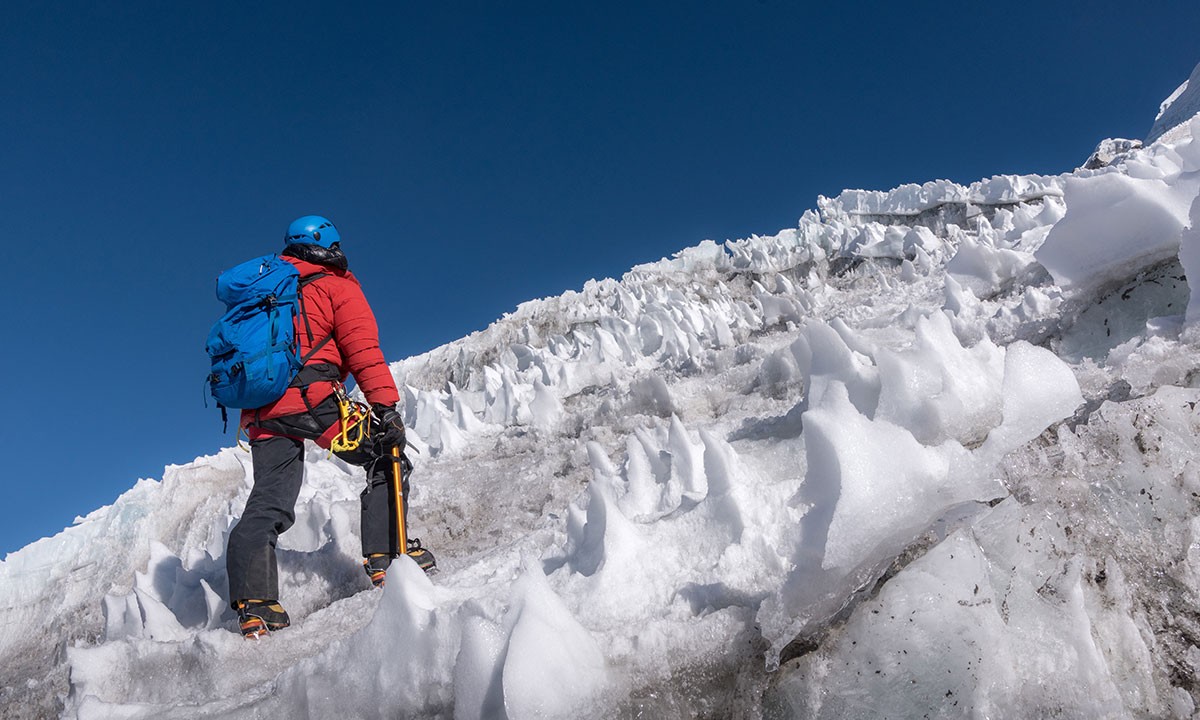 The Lobuche East Peak, at an elevation of 6,119 meters (20,075 feet), is the second most popular expedition peak in the Khumbu region, right after the Island Peak. Known for the arguably best summit view in the world, this Himalayan gem is classified as a ‘trekking peak’ that many mountaineering beginners take on before their big expedition on Mt. Everest and other 8,000-meter class mountains. The summit of Lobuche East Peak offers spectacular views of the Himalayan range, including 5 of the 14 highest mountains in the world, like Mt. Everest, Mt. Lhotse, Mt. Cho Oyu, Mt. Kanchenjunga, and Mt. Makalu.
The Lobuche East Peak, at an elevation of 6,119 meters (20,075 feet), is the second most popular expedition peak in the Khumbu region, right after the Island Peak. Known for the arguably best summit view in the world, this Himalayan gem is classified as a ‘trekking peak’ that many mountaineering beginners take on before their big expedition on Mt. Everest and other 8,000-meter class mountains. The summit of Lobuche East Peak offers spectacular views of the Himalayan range, including 5 of the 14 highest mountains in the world, like Mt. Everest, Mt. Lhotse, Mt. Cho Oyu, Mt. Kanchenjunga, and Mt. Makalu.
Following the classic route of the Everest Base Camp trekking, you can enjoy two exhilarating and fascinating Himalayan expeditions in one go; you will first trek to the highest base camp in the world, hike to Kalapatthar for a breathtaking sunrise view, and move on towards the main objective of this expedition, the conquest of the Lobuche East Peak. If you are looking to take your first steps as a mountaineer in the Himalayas or are a seasoned mountaineer who trying to test your mountaineering skills in an attempt to scale the highest mountain in the world, the Lobuche Peak Climbing is the perfect expedition for you.
Marvel Adventure’s guided Lobuche Peak Climbing expedition will help you to grasp your Himalayan dream; guided by expert mountaineering guides and professionally certified expedition crews, your safety and well-being will be our top priority. We will take care of every minor detail for you, so you can fully immerse in the experience instead of being a worrywart. Maintaining enough acclimatization days so that your body can properly adapt to the high-altitude environment, we also conduct pre-climbing training at the Lobuche camps to brush up your mountaineering skills and boost your confidence level.
Lobuche Peak Climbing in Autumn

Autumn (September to November) is one of the peak seasons for the Himalayan expedition in Nepal. This season offers stable, cool weather, dry walking trails, and simply unbeatable unprecedented view of the Himalayan vistas. As the climate is on the warmer side during this season, and the days are sunny-bright, you don’t have to be concerned that much about the harsh alpine environment. The monsoon-washed fresh terrain and cool-breezy morning and nights make it an ideal time for an outdoor adventure in the Himlayas.
Furthermore, it is also a festive season in Nepal that boasts some of the major Hindu festivals like Dashain, Tihar, and Chhath, which give an opportunity to explore the cultural prospects of the country as well. The average temperature of the Lobuche region ranges from 12°C to 20°C and can drop to -10°C during the late autumn.
Benefits of Lobuche Peak Climbing in Autumn
- Warm daylight trekking experience
- Low chances of rainfall and snowfall
- Stunning mountain views
- Fresh and well-nourished landscape by monsoon rain
- Opportunity to experience cultural enrichment
- Harvest season that offers an opportunity to relish the local delicacies
- Busy wildlife and migratory birds preparing for hibernation and migration
- Overall an ideal balanced weather for the Himalayan expedition
Lobuche Peak Climbing in Spring
Spring (March to May) is another peak season for high-altitude adventures in Nepal. If you are a nature lover, nothing beats the magnificence of colorful and delightful blooming trails of this season. The lower region of the Lobuche Peak Climbing trail is filled with the tranquility of wildflowers, lush vegetation, and Himalayan wildlife and birdlife, enjoying the comfort of the warm weather after winter.
The temperature of the Lobuche region during the spring season stays around 15°C to 20°C on average and drops to minus degrees at higher elevations during the nights and early morning.
Benefits of Lobuche Peak Climbing in Spring
- Blooming natural terrains all over the trail
- Low chances of rainfall and snowfall
- Long bright days perfect for the extended long-route adventure
- Himalayan flora and fauna at their peak
- Opportunity to taste fresh seasonal delicacies
- Clear skies, green lush landscape, and the white-clad magical peaks in perfect synch
- Less crowded routes compared to the autumn season
How Technical is Lobuche Peak Climbing?

The Lobuche Peak Climbing expedition has been graded a ‘Grade PD+’ level on the Alpine Grading System, which means it is a technically challenging peak, and in the Himalayan grading system, this peak expedition has been graded as a ‘Moderate Level Climb.’ Although it has more challenging slopes in comparison to training mountain peaks like Island Peak and Mera Peak, it is still a trekking peak that is often considered by mountaineering beginners as a practice peak.
Even though Lobuche is slightly difficult and can be daunting for the budding mountaineering enthusiast, this Himalayan peak offers a genuine mountaineering experience to the climbers and polishes their skills for higher expeditions. As a climber, you will need to use different mountaineering tools like crampons, ice axes, fixed ropes, Jumars, climbing ropes, etc, to scale the Lobuche East Peak. Overall, the Lobuche Peak Climbing expedition requires a good level of physical fitness and adequate mountaineering skills to overcome the technical segment on the slopes. Marvel Adventure also conducts pre-climbing training sessions (both equipment familiarization and pre-climb using the equipment) at the camps on the mountain to help you with the expedition and boost your confidence level.
Training and Preparation
Normally, the general training period for a high-altitude trekking adventure is around 4- 7 weeks; however, despite being a trekking peak, the Lobuche Peak Climbing is nothing like a trekking adventure. Unlike other trekking adventures, you will actually spend a significant time in the alpine environment (ice and snow) of the mountain. To top it all, the technical segments which require you to use mountaineering skills add up to the difficulty factor of the expedition to some extent. Thus, it is recommended that for this alpine adventure, you should at least start your training 2 to 3 months prior to the actual expedition.
In general, the Lobuche Peak Climbing expedition is a physically demanding adventure, so the better your physical fitness level, the more enjoyable your experience will be. It will be best if you evaluate your physical capabilities and design a training program to reach your fitness goal for the fitness. You can consult a physical fitness instructor and your guide for your proper physical assessment and further insights into designing your training regime. Here are a few exercises that you could include in your training program for the expedition.
Strength Training Exercises
- Push-ups
- Planks
- Squat
- Lunges
- Deadlift
- Weightlifting
- Benchpress
- Pull-ups
- Hammer Curl
- Dip
- Barbell curl
- Front raise
- Overhead press
Cardivascular Exercises
- Jogging
- Cycling
- Swimming
- Rowing
- Pilates
- Burpees
- Dance
- Jumping rope
- High knees
- Jumping jack
- Lateral shuffle







